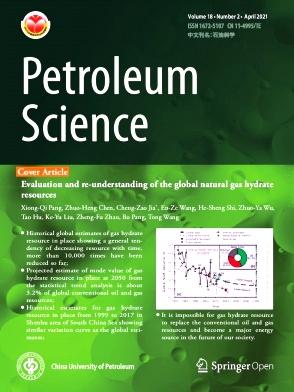Characteristics, preservation mechanisms, and significance of aragonite in lacustrine shale: A case study from the Jiyang Depression, Bohai Bay Basin
IF 6
1区 工程技术
Q2 ENERGY & FUELS
引用次数: 0
Abstract
Aragonite is a metastable mineral, which is easily transformed into calcite, and generally difficult to preserve in the stratum. However, large amounts of aragonites were found in the Paleogene shale of the Jiyang Depression. The characteristics and preservation mechanisms of these aragonites were analyzed through a series of analytical methods, including cathodoluminescence, field-emission scanning electron microscopy (FESEM), laser ablation inductively coupled plasma mass spectrometry (LA-ICP-MS), micro-area carbon and oxygen isotopes, Sr isotopes, and dissolution simulation experiments under high temperature and high pressure. The research results show that: ①Aragonite in the Paleogene shale of the Jiyang Depression is related to algal microbial fossils, primarily composed of coccoliths and characterized by two emission peaks at 420 nm and 480 nm in cathodoluminescence; ②The primary factor allowing biological aragonite to be preserved is the immaturity of the organic matter and the deficiency of abundant organic acids necessary for its dissolution or transformation, which is confirmed by the evidence of organic matter maturity and simulation experiments of organic acid dissolution on aragonite under high-temperature and high-pressure conditions. Additional factors that may aid in the preservation of aragonite are the ideal sedimentation conditions, the defense of organic coating, and the enclosed environment with tiny pores, low porosity, and low permeability; ③These aragonite-rich shales, characterized by coccolithophores, provide a solid evidence for seawater intrusion into terrestrial lake basin, and have a significant implication for the source and storage of shale oil.
湖相页岩中文石的特征、保存机制及其意义:渤海湾盆地济阳凹陷案例研究
文石是一种易变矿物,很容易转化为方解石,一般很难保存在地层中。然而,在济阳坳陷的古近纪页岩中发现了大量文石。通过阴极发光、场发射扫描电子显微镜(FESEM)、激光烧蚀电感耦合等离子体质谱(LA-ICP-MS)、微区碳氧同位素、锶同位素以及高温高压下的溶解模拟实验等一系列分析方法,分析了这些文石的特征和保存机制。研究结果表明济阳凹陷古近纪页岩中的文石与藻类微生物化石有关,主要由茧石组成,阴极发光在 420 nm 和 480 nm 处有两个发射峰;有机质成熟的证据和高温高压条件下有机酸溶解文石的模拟实验证实了这一点。有助于文石保存的其他因素还包括理想的沉积条件、有机涂层的保护以及孔隙微小、孔隙率低、渗透率低的封闭环境;③这些富含文石的页岩以茧石为特征,为海水侵入陆地湖盆提供了确凿证据,对页岩油的来源和储存具有重要意义。
本文章由计算机程序翻译,如有差异,请以英文原文为准。
求助全文
约1分钟内获得全文
求助全文
来源期刊

Petroleum Science
地学-地球化学与地球物理
CiteScore
7.70
自引率
16.10%
发文量
311
审稿时长
63 days
期刊介绍:
Petroleum Science is the only English journal in China on petroleum science and technology that is intended for professionals engaged in petroleum science research and technical applications all over the world, as well as the managerial personnel of oil companies. It covers petroleum geology, petroleum geophysics, petroleum engineering, petrochemistry & chemical engineering, petroleum mechanics, and economic management. It aims to introduce the latest results in oil industry research in China, promote cooperation in petroleum science research between China and the rest of the world, and build a bridge for scientific communication between China and the world.
 求助内容:
求助内容: 应助结果提醒方式:
应助结果提醒方式:


